University Essay: Personal Care Assistant for Elderly Patient
VerifiedAdded on 2022/11/23
|7
|2061
|310
Essay
AI Summary
This essay focuses on the care of a 77-year-old woman, Mrs. Mary Tonkin, living alone with multiple health issues, including atrial fibrillation, type 2 diabetes, and the after-effects of a stroke. The essay explores the necessity of a personal care assistant in her home to manage her symptoms, medication, and daily activities. It identifies resources such as an atrial fibrillation checklist and medication tracker that can be utilized by the registered nurse to monitor and manage Mary's health. The essay emphasizes the registered nurse's role in providing support, accessing resources, and coordinating care, as well as the benefits of home care in reducing the patient's anxiety and promoting a comfortable living environment. The conclusion highlights how a personal care assistant can effectively manage the patient's health conditions and improve their quality of life.
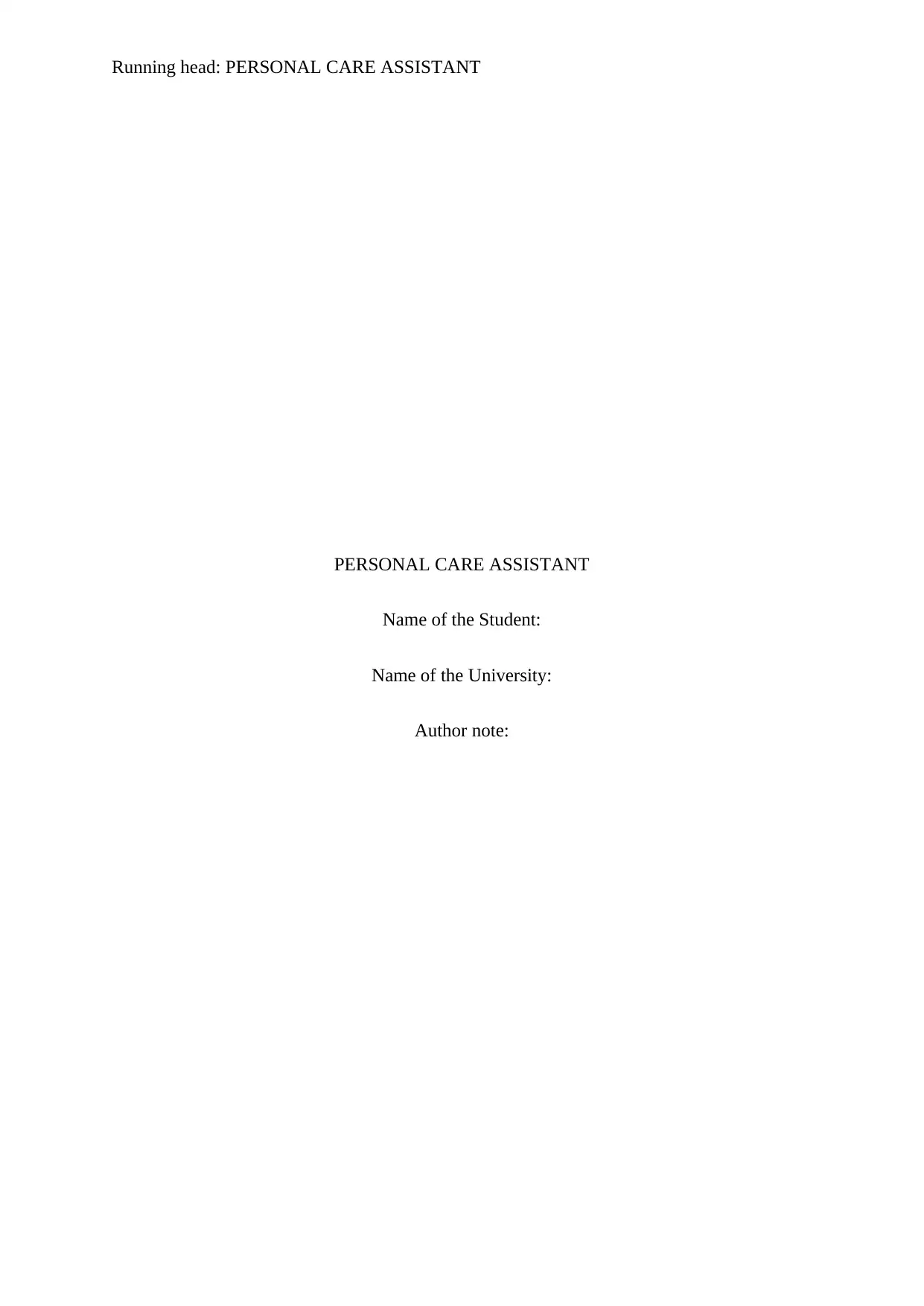
Running head: PERSONAL CARE ASSISTANT
PERSONAL CARE ASSISTANT
Name of the Student:
Name of the University:
Author note:
PERSONAL CARE ASSISTANT
Name of the Student:
Name of the University:
Author note:
Paraphrase This Document
Need a fresh take? Get an instant paraphrase of this document with our AI Paraphraser
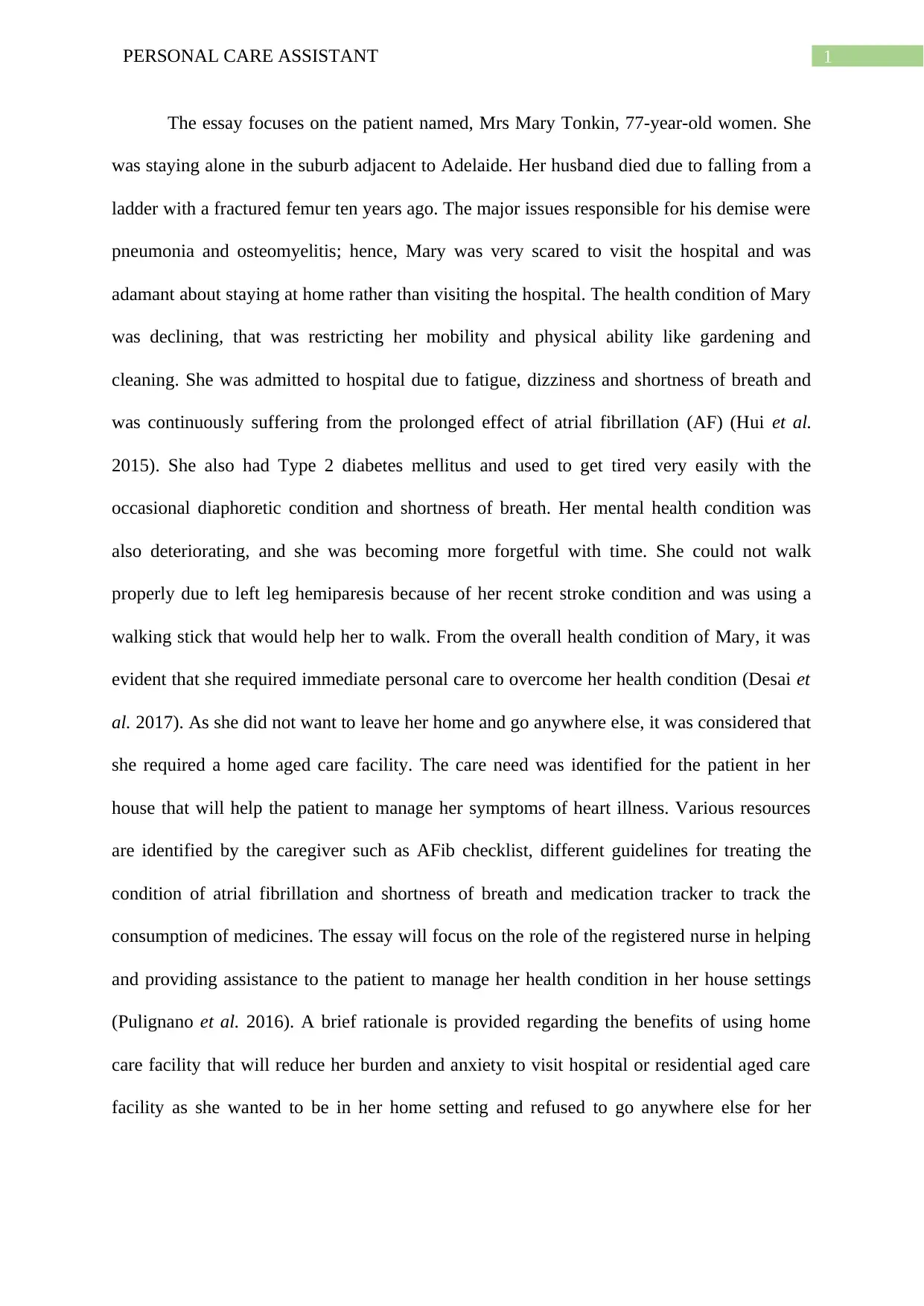
1PERSONAL CARE ASSISTANT
The essay focuses on the patient named, Mrs Mary Tonkin, 77-year-old women. She
was staying alone in the suburb adjacent to Adelaide. Her husband died due to falling from a
ladder with a fractured femur ten years ago. The major issues responsible for his demise were
pneumonia and osteomyelitis; hence, Mary was very scared to visit the hospital and was
adamant about staying at home rather than visiting the hospital. The health condition of Mary
was declining, that was restricting her mobility and physical ability like gardening and
cleaning. She was admitted to hospital due to fatigue, dizziness and shortness of breath and
was continuously suffering from the prolonged effect of atrial fibrillation (AF) (Hui et al.
2015). She also had Type 2 diabetes mellitus and used to get tired very easily with the
occasional diaphoretic condition and shortness of breath. Her mental health condition was
also deteriorating, and she was becoming more forgetful with time. She could not walk
properly due to left leg hemiparesis because of her recent stroke condition and was using a
walking stick that would help her to walk. From the overall health condition of Mary, it was
evident that she required immediate personal care to overcome her health condition (Desai et
al. 2017). As she did not want to leave her home and go anywhere else, it was considered that
she required a home aged care facility. The care need was identified for the patient in her
house that will help the patient to manage her symptoms of heart illness. Various resources
are identified by the caregiver such as AFib checklist, different guidelines for treating the
condition of atrial fibrillation and shortness of breath and medication tracker to track the
consumption of medicines. The essay will focus on the role of the registered nurse in helping
and providing assistance to the patient to manage her health condition in her house settings
(Pulignano et al. 2016). A brief rationale is provided regarding the benefits of using home
care facility that will reduce her burden and anxiety to visit hospital or residential aged care
facility as she wanted to be in her home setting and refused to go anywhere else for her
The essay focuses on the patient named, Mrs Mary Tonkin, 77-year-old women. She
was staying alone in the suburb adjacent to Adelaide. Her husband died due to falling from a
ladder with a fractured femur ten years ago. The major issues responsible for his demise were
pneumonia and osteomyelitis; hence, Mary was very scared to visit the hospital and was
adamant about staying at home rather than visiting the hospital. The health condition of Mary
was declining, that was restricting her mobility and physical ability like gardening and
cleaning. She was admitted to hospital due to fatigue, dizziness and shortness of breath and
was continuously suffering from the prolonged effect of atrial fibrillation (AF) (Hui et al.
2015). She also had Type 2 diabetes mellitus and used to get tired very easily with the
occasional diaphoretic condition and shortness of breath. Her mental health condition was
also deteriorating, and she was becoming more forgetful with time. She could not walk
properly due to left leg hemiparesis because of her recent stroke condition and was using a
walking stick that would help her to walk. From the overall health condition of Mary, it was
evident that she required immediate personal care to overcome her health condition (Desai et
al. 2017). As she did not want to leave her home and go anywhere else, it was considered that
she required a home aged care facility. The care need was identified for the patient in her
house that will help the patient to manage her symptoms of heart illness. Various resources
are identified by the caregiver such as AFib checklist, different guidelines for treating the
condition of atrial fibrillation and shortness of breath and medication tracker to track the
consumption of medicines. The essay will focus on the role of the registered nurse in helping
and providing assistance to the patient to manage her health condition in her house settings
(Pulignano et al. 2016). A brief rationale is provided regarding the benefits of using home
care facility that will reduce her burden and anxiety to visit hospital or residential aged care
facility as she wanted to be in her home setting and refused to go anywhere else for her
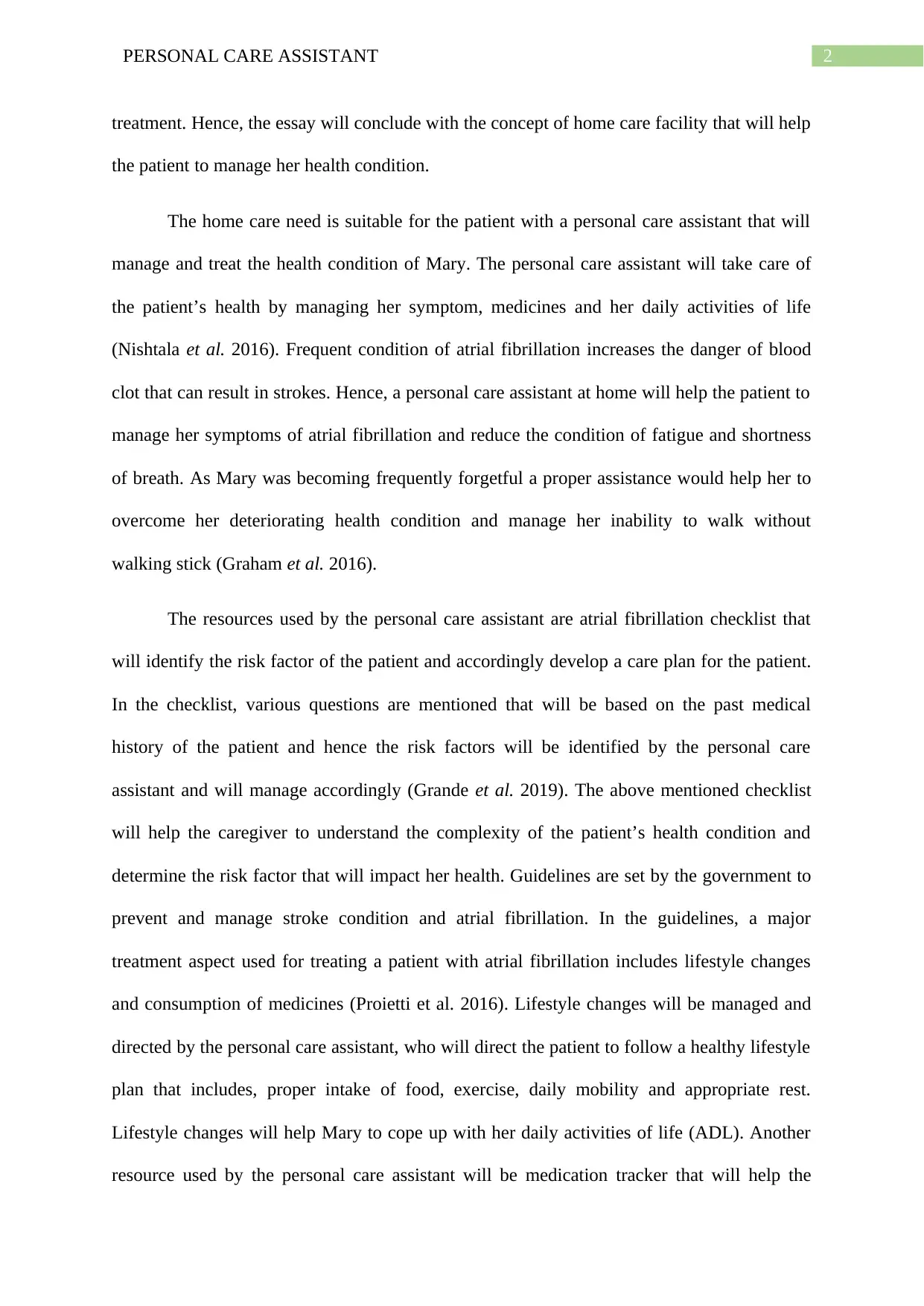
2PERSONAL CARE ASSISTANT
treatment. Hence, the essay will conclude with the concept of home care facility that will help
the patient to manage her health condition.
The home care need is suitable for the patient with a personal care assistant that will
manage and treat the health condition of Mary. The personal care assistant will take care of
the patient’s health by managing her symptom, medicines and her daily activities of life
(Nishtala et al. 2016). Frequent condition of atrial fibrillation increases the danger of blood
clot that can result in strokes. Hence, a personal care assistant at home will help the patient to
manage her symptoms of atrial fibrillation and reduce the condition of fatigue and shortness
of breath. As Mary was becoming frequently forgetful a proper assistance would help her to
overcome her deteriorating health condition and manage her inability to walk without
walking stick (Graham et al. 2016).
The resources used by the personal care assistant are atrial fibrillation checklist that
will identify the risk factor of the patient and accordingly develop a care plan for the patient.
In the checklist, various questions are mentioned that will be based on the past medical
history of the patient and hence the risk factors will be identified by the personal care
assistant and will manage accordingly (Grande et al. 2019). The above mentioned checklist
will help the caregiver to understand the complexity of the patient’s health condition and
determine the risk factor that will impact her health. Guidelines are set by the government to
prevent and manage stroke condition and atrial fibrillation. In the guidelines, a major
treatment aspect used for treating a patient with atrial fibrillation includes lifestyle changes
and consumption of medicines (Proietti et al. 2016). Lifestyle changes will be managed and
directed by the personal care assistant, who will direct the patient to follow a healthy lifestyle
plan that includes, proper intake of food, exercise, daily mobility and appropriate rest.
Lifestyle changes will help Mary to cope up with her daily activities of life (ADL). Another
resource used by the personal care assistant will be medication tracker that will help the
treatment. Hence, the essay will conclude with the concept of home care facility that will help
the patient to manage her health condition.
The home care need is suitable for the patient with a personal care assistant that will
manage and treat the health condition of Mary. The personal care assistant will take care of
the patient’s health by managing her symptom, medicines and her daily activities of life
(Nishtala et al. 2016). Frequent condition of atrial fibrillation increases the danger of blood
clot that can result in strokes. Hence, a personal care assistant at home will help the patient to
manage her symptoms of atrial fibrillation and reduce the condition of fatigue and shortness
of breath. As Mary was becoming frequently forgetful a proper assistance would help her to
overcome her deteriorating health condition and manage her inability to walk without
walking stick (Graham et al. 2016).
The resources used by the personal care assistant are atrial fibrillation checklist that
will identify the risk factor of the patient and accordingly develop a care plan for the patient.
In the checklist, various questions are mentioned that will be based on the past medical
history of the patient and hence the risk factors will be identified by the personal care
assistant and will manage accordingly (Grande et al. 2019). The above mentioned checklist
will help the caregiver to understand the complexity of the patient’s health condition and
determine the risk factor that will impact her health. Guidelines are set by the government to
prevent and manage stroke condition and atrial fibrillation. In the guidelines, a major
treatment aspect used for treating a patient with atrial fibrillation includes lifestyle changes
and consumption of medicines (Proietti et al. 2016). Lifestyle changes will be managed and
directed by the personal care assistant, who will direct the patient to follow a healthy lifestyle
plan that includes, proper intake of food, exercise, daily mobility and appropriate rest.
Lifestyle changes will help Mary to cope up with her daily activities of life (ADL). Another
resource used by the personal care assistant will be medication tracker that will help the
⊘ This is a preview!⊘
Do you want full access?
Subscribe today to unlock all pages.

Trusted by 1+ million students worldwide
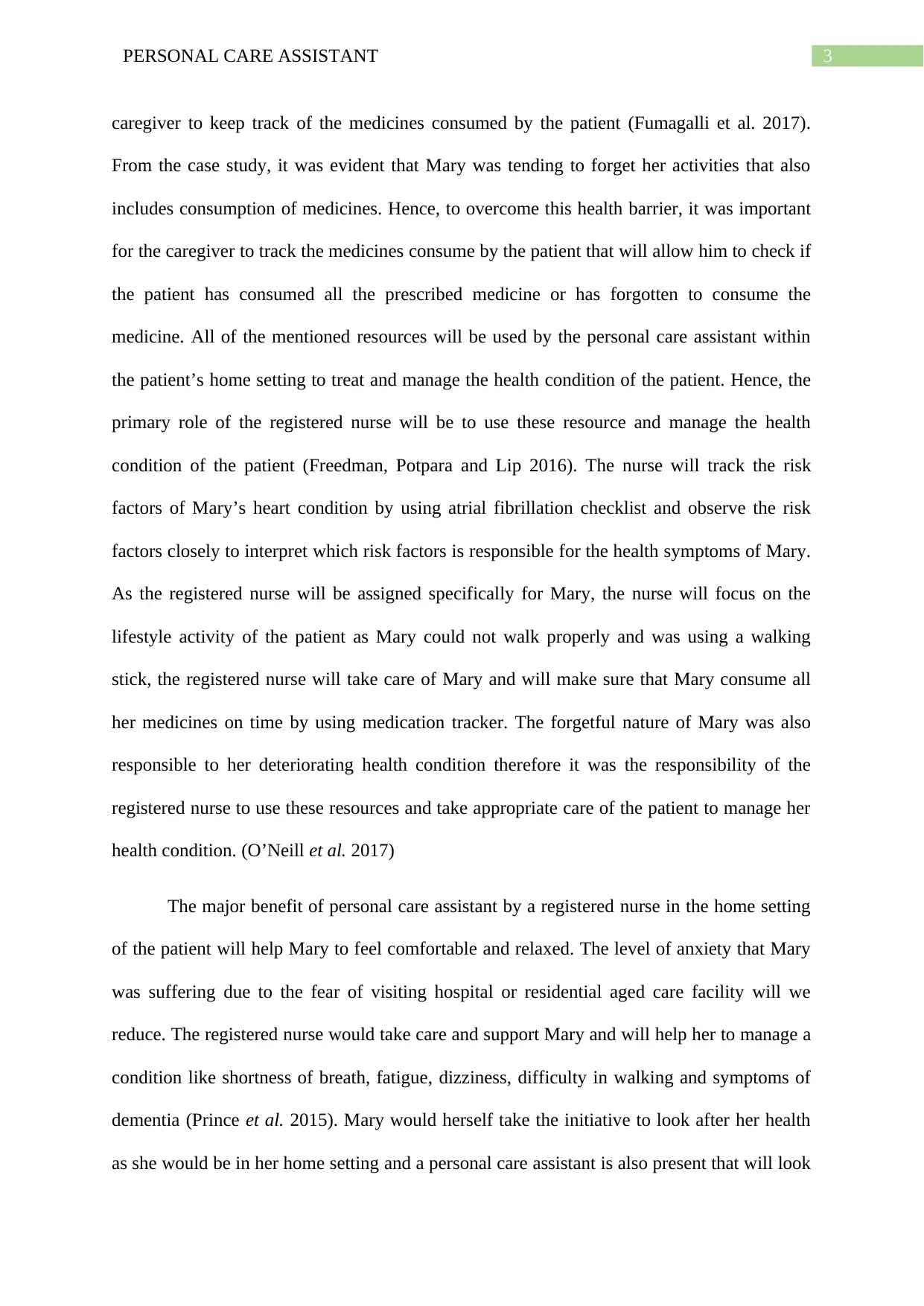
3PERSONAL CARE ASSISTANT
caregiver to keep track of the medicines consumed by the patient (Fumagalli et al. 2017).
From the case study, it was evident that Mary was tending to forget her activities that also
includes consumption of medicines. Hence, to overcome this health barrier, it was important
for the caregiver to track the medicines consume by the patient that will allow him to check if
the patient has consumed all the prescribed medicine or has forgotten to consume the
medicine. All of the mentioned resources will be used by the personal care assistant within
the patient’s home setting to treat and manage the health condition of the patient. Hence, the
primary role of the registered nurse will be to use these resource and manage the health
condition of the patient (Freedman, Potpara and Lip 2016). The nurse will track the risk
factors of Mary’s heart condition by using atrial fibrillation checklist and observe the risk
factors closely to interpret which risk factors is responsible for the health symptoms of Mary.
As the registered nurse will be assigned specifically for Mary, the nurse will focus on the
lifestyle activity of the patient as Mary could not walk properly and was using a walking
stick, the registered nurse will take care of Mary and will make sure that Mary consume all
her medicines on time by using medication tracker. The forgetful nature of Mary was also
responsible to her deteriorating health condition therefore it was the responsibility of the
registered nurse to use these resources and take appropriate care of the patient to manage her
health condition. (O’Neill et al. 2017)
The major benefit of personal care assistant by a registered nurse in the home setting
of the patient will help Mary to feel comfortable and relaxed. The level of anxiety that Mary
was suffering due to the fear of visiting hospital or residential aged care facility will we
reduce. The registered nurse would take care and support Mary and will help her to manage a
condition like shortness of breath, fatigue, dizziness, difficulty in walking and symptoms of
dementia (Prince et al. 2015). Mary would herself take the initiative to look after her health
as she would be in her home setting and a personal care assistant is also present that will look
caregiver to keep track of the medicines consumed by the patient (Fumagalli et al. 2017).
From the case study, it was evident that Mary was tending to forget her activities that also
includes consumption of medicines. Hence, to overcome this health barrier, it was important
for the caregiver to track the medicines consume by the patient that will allow him to check if
the patient has consumed all the prescribed medicine or has forgotten to consume the
medicine. All of the mentioned resources will be used by the personal care assistant within
the patient’s home setting to treat and manage the health condition of the patient. Hence, the
primary role of the registered nurse will be to use these resource and manage the health
condition of the patient (Freedman, Potpara and Lip 2016). The nurse will track the risk
factors of Mary’s heart condition by using atrial fibrillation checklist and observe the risk
factors closely to interpret which risk factors is responsible for the health symptoms of Mary.
As the registered nurse will be assigned specifically for Mary, the nurse will focus on the
lifestyle activity of the patient as Mary could not walk properly and was using a walking
stick, the registered nurse will take care of Mary and will make sure that Mary consume all
her medicines on time by using medication tracker. The forgetful nature of Mary was also
responsible to her deteriorating health condition therefore it was the responsibility of the
registered nurse to use these resources and take appropriate care of the patient to manage her
health condition. (O’Neill et al. 2017)
The major benefit of personal care assistant by a registered nurse in the home setting
of the patient will help Mary to feel comfortable and relaxed. The level of anxiety that Mary
was suffering due to the fear of visiting hospital or residential aged care facility will we
reduce. The registered nurse would take care and support Mary and will help her to manage a
condition like shortness of breath, fatigue, dizziness, difficulty in walking and symptoms of
dementia (Prince et al. 2015). Mary would herself take the initiative to look after her health
as she would be in her home setting and a personal care assistant is also present that will look
Paraphrase This Document
Need a fresh take? Get an instant paraphrase of this document with our AI Paraphraser
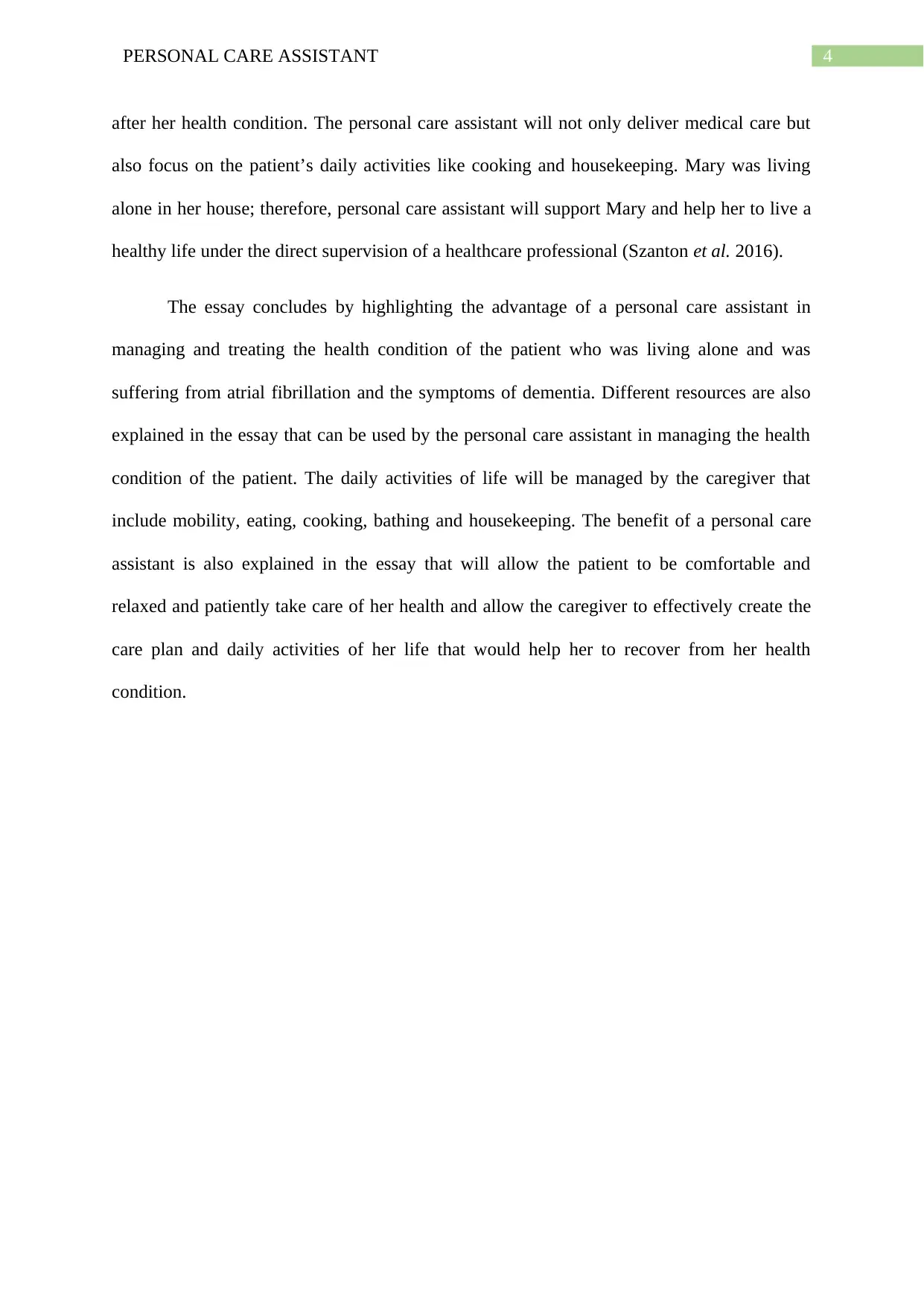
4PERSONAL CARE ASSISTANT
after her health condition. The personal care assistant will not only deliver medical care but
also focus on the patient’s daily activities like cooking and housekeeping. Mary was living
alone in her house; therefore, personal care assistant will support Mary and help her to live a
healthy life under the direct supervision of a healthcare professional (Szanton et al. 2016).
The essay concludes by highlighting the advantage of a personal care assistant in
managing and treating the health condition of the patient who was living alone and was
suffering from atrial fibrillation and the symptoms of dementia. Different resources are also
explained in the essay that can be used by the personal care assistant in managing the health
condition of the patient. The daily activities of life will be managed by the caregiver that
include mobility, eating, cooking, bathing and housekeeping. The benefit of a personal care
assistant is also explained in the essay that will allow the patient to be comfortable and
relaxed and patiently take care of her health and allow the caregiver to effectively create the
care plan and daily activities of her life that would help her to recover from her health
condition.
after her health condition. The personal care assistant will not only deliver medical care but
also focus on the patient’s daily activities like cooking and housekeeping. Mary was living
alone in her house; therefore, personal care assistant will support Mary and help her to live a
healthy life under the direct supervision of a healthcare professional (Szanton et al. 2016).
The essay concludes by highlighting the advantage of a personal care assistant in
managing and treating the health condition of the patient who was living alone and was
suffering from atrial fibrillation and the symptoms of dementia. Different resources are also
explained in the essay that can be used by the personal care assistant in managing the health
condition of the patient. The daily activities of life will be managed by the caregiver that
include mobility, eating, cooking, bathing and housekeeping. The benefit of a personal care
assistant is also explained in the essay that will allow the patient to be comfortable and
relaxed and patiently take care of her health and allow the caregiver to effectively create the
care plan and daily activities of her life that would help her to recover from her health
condition.
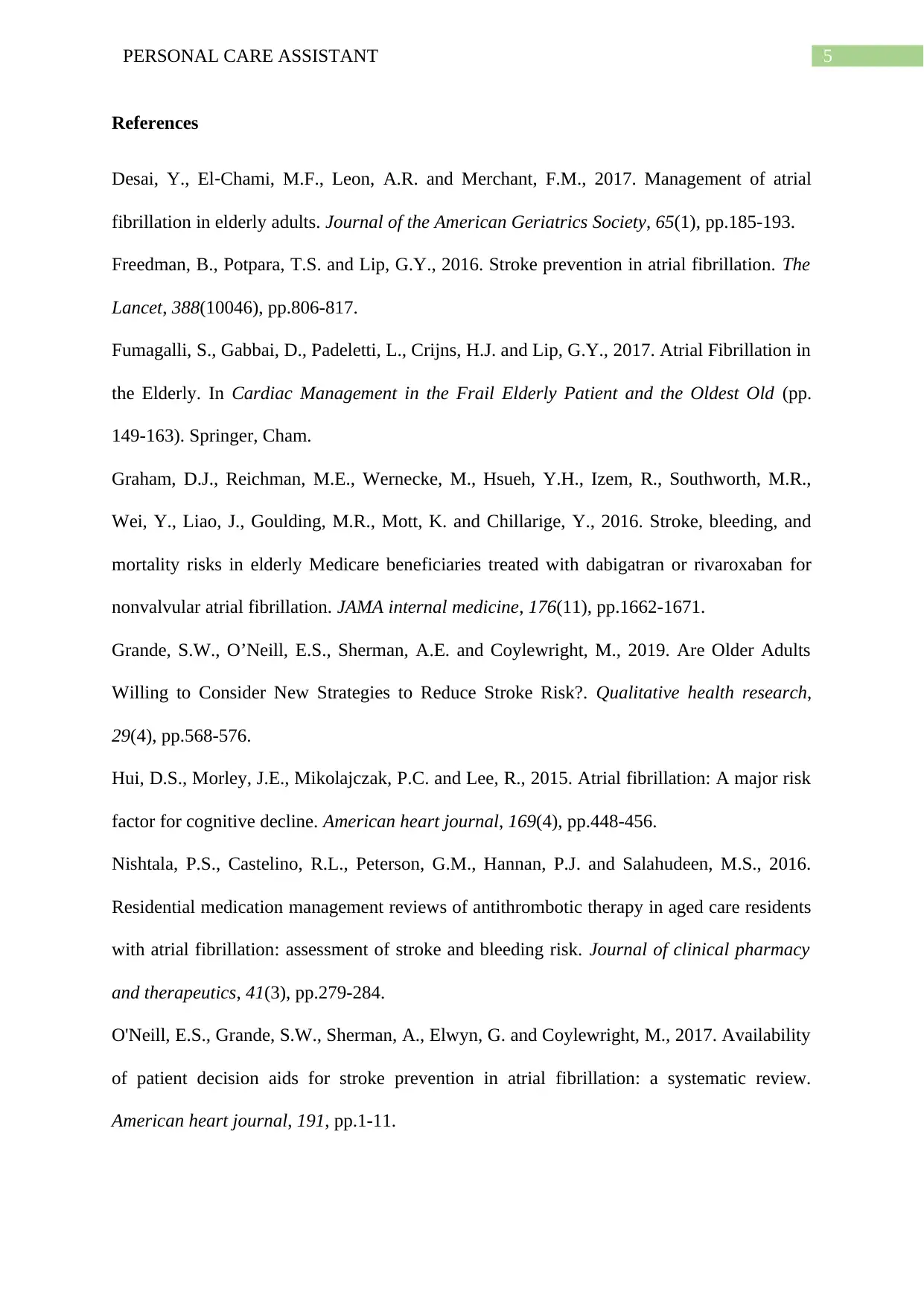
5PERSONAL CARE ASSISTANT
References
Desai, Y., El‐Chami, M.F., Leon, A.R. and Merchant, F.M., 2017. Management of atrial
fibrillation in elderly adults. Journal of the American Geriatrics Society, 65(1), pp.185-193.
Freedman, B., Potpara, T.S. and Lip, G.Y., 2016. Stroke prevention in atrial fibrillation. The
Lancet, 388(10046), pp.806-817.
Fumagalli, S., Gabbai, D., Padeletti, L., Crijns, H.J. and Lip, G.Y., 2017. Atrial Fibrillation in
the Elderly. In Cardiac Management in the Frail Elderly Patient and the Oldest Old (pp.
149-163). Springer, Cham.
Graham, D.J., Reichman, M.E., Wernecke, M., Hsueh, Y.H., Izem, R., Southworth, M.R.,
Wei, Y., Liao, J., Goulding, M.R., Mott, K. and Chillarige, Y., 2016. Stroke, bleeding, and
mortality risks in elderly Medicare beneficiaries treated with dabigatran or rivaroxaban for
nonvalvular atrial fibrillation. JAMA internal medicine, 176(11), pp.1662-1671.
Grande, S.W., O’Neill, E.S., Sherman, A.E. and Coylewright, M., 2019. Are Older Adults
Willing to Consider New Strategies to Reduce Stroke Risk?. Qualitative health research,
29(4), pp.568-576.
Hui, D.S., Morley, J.E., Mikolajczak, P.C. and Lee, R., 2015. Atrial fibrillation: A major risk
factor for cognitive decline. American heart journal, 169(4), pp.448-456.
Nishtala, P.S., Castelino, R.L., Peterson, G.M., Hannan, P.J. and Salahudeen, M.S., 2016.
Residential medication management reviews of antithrombotic therapy in aged care residents
with atrial fibrillation: assessment of stroke and bleeding risk. Journal of clinical pharmacy
and therapeutics, 41(3), pp.279-284.
O'Neill, E.S., Grande, S.W., Sherman, A., Elwyn, G. and Coylewright, M., 2017. Availability
of patient decision aids for stroke prevention in atrial fibrillation: a systematic review.
American heart journal, 191, pp.1-11.
References
Desai, Y., El‐Chami, M.F., Leon, A.R. and Merchant, F.M., 2017. Management of atrial
fibrillation in elderly adults. Journal of the American Geriatrics Society, 65(1), pp.185-193.
Freedman, B., Potpara, T.S. and Lip, G.Y., 2016. Stroke prevention in atrial fibrillation. The
Lancet, 388(10046), pp.806-817.
Fumagalli, S., Gabbai, D., Padeletti, L., Crijns, H.J. and Lip, G.Y., 2017. Atrial Fibrillation in
the Elderly. In Cardiac Management in the Frail Elderly Patient and the Oldest Old (pp.
149-163). Springer, Cham.
Graham, D.J., Reichman, M.E., Wernecke, M., Hsueh, Y.H., Izem, R., Southworth, M.R.,
Wei, Y., Liao, J., Goulding, M.R., Mott, K. and Chillarige, Y., 2016. Stroke, bleeding, and
mortality risks in elderly Medicare beneficiaries treated with dabigatran or rivaroxaban for
nonvalvular atrial fibrillation. JAMA internal medicine, 176(11), pp.1662-1671.
Grande, S.W., O’Neill, E.S., Sherman, A.E. and Coylewright, M., 2019. Are Older Adults
Willing to Consider New Strategies to Reduce Stroke Risk?. Qualitative health research,
29(4), pp.568-576.
Hui, D.S., Morley, J.E., Mikolajczak, P.C. and Lee, R., 2015. Atrial fibrillation: A major risk
factor for cognitive decline. American heart journal, 169(4), pp.448-456.
Nishtala, P.S., Castelino, R.L., Peterson, G.M., Hannan, P.J. and Salahudeen, M.S., 2016.
Residential medication management reviews of antithrombotic therapy in aged care residents
with atrial fibrillation: assessment of stroke and bleeding risk. Journal of clinical pharmacy
and therapeutics, 41(3), pp.279-284.
O'Neill, E.S., Grande, S.W., Sherman, A., Elwyn, G. and Coylewright, M., 2017. Availability
of patient decision aids for stroke prevention in atrial fibrillation: a systematic review.
American heart journal, 191, pp.1-11.
⊘ This is a preview!⊘
Do you want full access?
Subscribe today to unlock all pages.

Trusted by 1+ million students worldwide
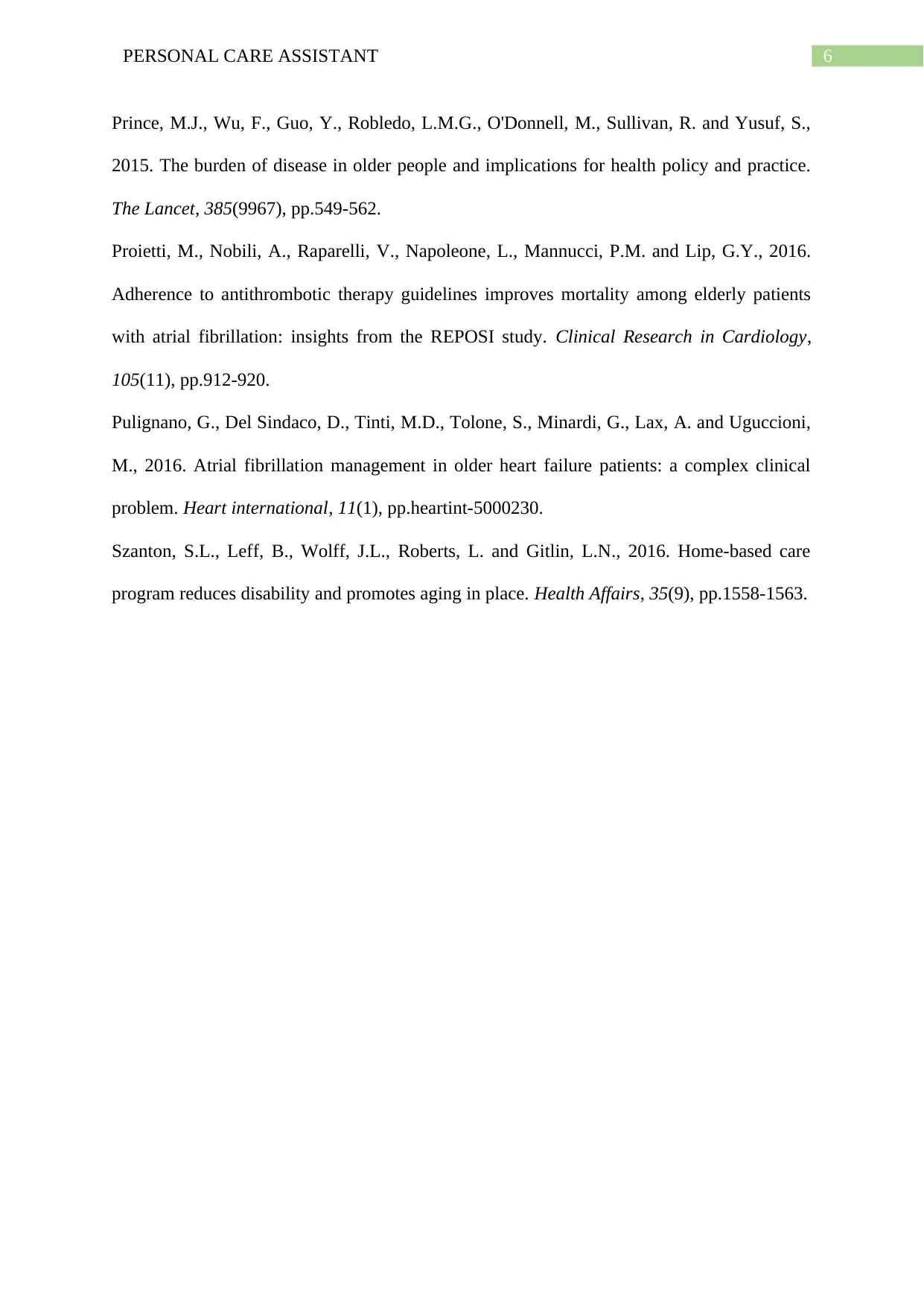
6PERSONAL CARE ASSISTANT
Prince, M.J., Wu, F., Guo, Y., Robledo, L.M.G., O'Donnell, M., Sullivan, R. and Yusuf, S.,
2015. The burden of disease in older people and implications for health policy and practice.
The Lancet, 385(9967), pp.549-562.
Proietti, M., Nobili, A., Raparelli, V., Napoleone, L., Mannucci, P.M. and Lip, G.Y., 2016.
Adherence to antithrombotic therapy guidelines improves mortality among elderly patients
with atrial fibrillation: insights from the REPOSI study. Clinical Research in Cardiology,
105(11), pp.912-920.
Pulignano, G., Del Sindaco, D., Tinti, M.D., Tolone, S., Minardi, G., Lax, A. and Uguccioni,
M., 2016. Atrial fibrillation management in older heart failure patients: a complex clinical
problem. Heart international, 11(1), pp.heartint-5000230.
Szanton, S.L., Leff, B., Wolff, J.L., Roberts, L. and Gitlin, L.N., 2016. Home-based care
program reduces disability and promotes aging in place. Health Affairs, 35(9), pp.1558-1563.
Prince, M.J., Wu, F., Guo, Y., Robledo, L.M.G., O'Donnell, M., Sullivan, R. and Yusuf, S.,
2015. The burden of disease in older people and implications for health policy and practice.
The Lancet, 385(9967), pp.549-562.
Proietti, M., Nobili, A., Raparelli, V., Napoleone, L., Mannucci, P.M. and Lip, G.Y., 2016.
Adherence to antithrombotic therapy guidelines improves mortality among elderly patients
with atrial fibrillation: insights from the REPOSI study. Clinical Research in Cardiology,
105(11), pp.912-920.
Pulignano, G., Del Sindaco, D., Tinti, M.D., Tolone, S., Minardi, G., Lax, A. and Uguccioni,
M., 2016. Atrial fibrillation management in older heart failure patients: a complex clinical
problem. Heart international, 11(1), pp.heartint-5000230.
Szanton, S.L., Leff, B., Wolff, J.L., Roberts, L. and Gitlin, L.N., 2016. Home-based care
program reduces disability and promotes aging in place. Health Affairs, 35(9), pp.1558-1563.
1 out of 7
Related Documents
Your All-in-One AI-Powered Toolkit for Academic Success.
+13062052269
info@desklib.com
Available 24*7 on WhatsApp / Email
![[object Object]](/_next/static/media/star-bottom.7253800d.svg)
Unlock your academic potential
Copyright © 2020–2025 A2Z Services. All Rights Reserved. Developed and managed by ZUCOL.




